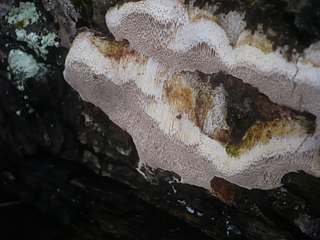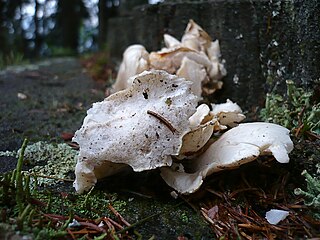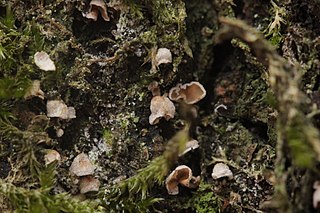
The Cantharellaceae are a family of fungi in the order Cantharellales. The family contains the chanterelles and related species, a group of fungi that superficially resemble agarics but have smooth, wrinkled, or gill-like hymenophores. Species in the family are ectomycorrhizal, forming a mutually beneficial relationship with the roots of trees and other plants. Many of the Cantharellaceae, including the chanterelle, the Pacific golden chanterelle, the horn of plenty, and the trumpet chanterelle, are not only edible, but are collected and marketed internationally on a commercial scale.

Ryan Henk Donk is a professional footballer who plays as a centre-back for Süper Lig club Kasımpaşa. Born in the Netherlands, he represents the Suriname national team.

Antrodia albida is a species of fungus in the genus Antrodia that grows on the dead wood of deciduous trees. A widely distributed species, it is found in Africa, Asia, Europe, Oceania, North America, and South America. The fungus was first described under the name Daedalea albida by Elias Magnus Fries in his 1815 work Observationes mycologicae. Marinus Anton Donk transferred it to Antrodia in 1960.

Perenniporia medulla-panis is a species of poroid fungus in the family Polyporaceae. It is a plant pathogen that infects stone fruit trees. The species was first described by Nikolaus Joseph von Jacquin in 1778. Marinus Anton Donk transferred it to the genus Perenniporia in 1967.

The Hydnaceae are a family of fungi in the order Cantharellales. Originally the family encompassed all species of fungi that produced basidiocarps having a hymenium consisting of slender, downward-hanging tapering extensions referred to as "spines" or "teeth", whether they were related or not. This artificial but often useful grouping is now more generally called the hydnoid or tooth fungi. In the strict, modern sense, the Hydnaceae are limited to the genus Hydnum and related genera, with basidiocarps having a toothed or poroid hymenium. Species in the family are ectomycorrhizal, forming a mutually beneficial relationship with the roots of trees and other plants. Hydnum repandum is an edible species, commercially collected in some countries and often marketed under the French name pied de mouton.

The Ganodermataceae are a family of fungi in the order Polyporales. As of April 2018, Index Fungorum accepts 8 genera and 300 species in the family. The family was circumscribed by Dutch mycologist Marinus Anton Donk in 1948 to contain polypores with a double spore wall. The inner wall is verruculose to ornamented, thickened and usually coloured, while the outer wall is thin and hyaline.

The Phanerochaetaceae are a family of mostly crust fungi in the order Polyporales.

The Bankeraceae are a family of fungi in the order Thelephorales. Taxa are terrestrial, and ectomycorrhizal with plant species in families such as Pinaceae or Fagaceae. The family was circumscribed by Marinus Anton Donk in 1961. According to a 2008 estimate, the family contains 6 genera and 98 species.

Ceriporia is a widely distributed genus of crust fungi.

Osteina is a fungal genus in the family Fomitopsidaceae. It is a monotypic genus that contains the single species Osteina obducta. The genus was circumscribed by mycologist Marinus Anton Donk in 1966, with Polyporus obductus as the type species.

Hyphoderma is a genus of crust fungi in the family Meruliaceae. It was circumscribed by German botanist Karl Friedrich Wilhelm Wallroth in 1833.

Entoloma abortivum, commonly known as the aborted entoloma or shrimp of the woods, is an edible mushroom in the Entolomataceae family of fungi. Caution should be used in identifying the species before eating. First named Clitopilus abortivus by Miles Joseph Berkeley and Moses Ashley Curtis, it was given its current name by the Dutch mycologist Marinus Anton Donk in 1949.

The clavarioid fungi are a group of fungi in the Basidiomycota typically having erect, simple or branched basidiocarps that are formed on the ground, on decaying vegetation, or on dead wood. They are colloquially called club fungi and coral fungi.

The cyphelloid fungi are a group of fungi in the Basidiomycota that have disc-, tube-, or cup-shaped basidiocarps, resembling species of discomycetes in the Ascomycota. They were originally referred to the genus Cyphella and subsequently to the family Cyphellaceae, but are now known to be much more diverse and are spread through several different genera and families. Since they are often studied as a group, it is convenient to call them by the informal (non-taxonomic) name of "cyphelloid fungi". Better known cyphelloid genera include Calyptella, with stalked, cup- or bell-like fruit bodies; Lachnella, with conspicuous, hairy-margined, disc-like fruit bodies; Flagelloscypha with smaller, but equally hairy, cup-like fruit bodies; Henningsomyces with tube-like fruit bodies; and Merismodes with clustered, hairy, cup-like fruit bodies.
Marinus Anton Donk was a Dutch mycologist. He specialized in the taxonomy and nomenclature of mushrooms. Rolf Singer wrote in his obituary that he was "one of the most outstanding figures of contemporary mycology."

Rhizoctonia is a genus of fungi in the order Cantharellales. Species form thin, effused, corticioid basidiocarps, but are most frequently found in their sterile, anamorphic state. Rhizoctonia species are saprotrophic, but some are also facultative plant pathogens, causing commercially important crop diseases. Some are also endomycorrhizal associates of orchids. The genus name was formerly used to accommodate many superficially similar, but unrelated fungi.

Clavariadelphus ligula, commonly known as the strap coral, is a species of fungus in the family Gomphaceae. It produces club-shaped fruit bodies with spongy flesh that grow in groups on the forest floor. It is found in Asia, Europe, and North America.

Daniëlle van de Donk is a Dutch professional footballer who plays as a midfielder for French Division 1 Féminine club Olympique Lyonnais and the Netherlands national team. She helped her national team to win the UEFA Women's Euro 2017 and finish second at the 2019 FIFA Women's World Cup.

The Irpicaceae are a family of mostly polypores and crust fungi in the order Polyporales.

Chromocyphella muscicola is a species of fungus in the family Hymenogastraceae. Basidiocarps are cyphelloid, cup-shaped, about 4 mm across, with an upper surface covered with fine hairs and a smooth underside.



















